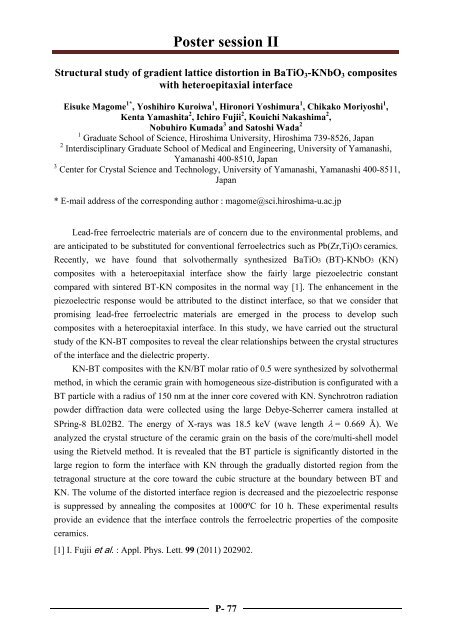Poster Session I - University of Ulsan
Poster Session I - University of Ulsan
Poster Session I - University of Ulsan
You also want an ePaper? Increase the reach of your titles
YUMPU automatically turns print PDFs into web optimized ePapers that Google loves.
<strong>Poster</strong> session II<br />
Structural study <strong>of</strong> gradient lattice distortion in BaTiO3-KNbO3 composites<br />
with heteroepitaxial interface<br />
Eisuke Magome 1* , Yoshihiro Kuroiwa 1 , Hironori Yoshimura 1 , Chikako Moriyoshi 1 ,<br />
Kenta Yamashita 2 , Ichiro Fujii 2 , Kouichi Nakashima 2 ,<br />
Nobuhiro Kumada 3 and Satoshi Wada 2<br />
1 Graduate School <strong>of</strong> Science, Hiroshima <strong>University</strong>, Hiroshima 739-8526, Japan<br />
2 Interdisciplinary Graduate School <strong>of</strong> Medical and Engineering, <strong>University</strong> <strong>of</strong> Yamanashi,<br />
Yamanashi 400-8510, Japan<br />
3 Center for Crystal Science and Technology, <strong>University</strong> <strong>of</strong> Yamanashi, Yamanashi 400-8511,<br />
Japan<br />
* E-mail address <strong>of</strong> the corresponding author : magome@sci.hiroshima-u.ac.jp<br />
Lead-free ferroelectric materials are <strong>of</strong> concern due to the environmental problems, and<br />
are anticipated to be substituted for conventional ferroelectrics such as Pb(Zr,Ti)O3 ceramics.<br />
Recently, we have found that solvothermally synthesized BaTiO3 (BT)-KNbO3 (KN)<br />
composites with a heteroepitaxial interface show the fairly large piezoelectric constant<br />
compared with sintered BT-KN composites in the normal way [1]. The enhancement in the<br />
piezoelectric response would be attributed to the distinct interface, so that we consider that<br />
promising lead-free ferroelectric materials are emerged in the process to develop such<br />
composites with a heteroepitaxial interface. In this study, we have carried out the structural<br />
study <strong>of</strong> the KN-BT composites to reveal the clear relationships between the crystal structures<br />
<strong>of</strong> the interface and the dielectric property.<br />
KN-BT composites with the KN/BT molar ratio <strong>of</strong> 0.5 were synthesized by solvothermal<br />
method, in which the ceramic grain with homogeneous size-distribution is configurated with a<br />
BT particle with a radius <strong>of</strong> 150 nm at the inner core covered with KN. Synchrotron radiation<br />
powder diffraction data were collected using the large Debye-Scherrer camera installed at<br />
SPring-8 BL02B2. The energy <strong>of</strong> X-rays was 18.5 keV (wave length ��= 0.669 Å). We<br />
analyzed the crystal structure <strong>of</strong> the ceramic grain on the basis <strong>of</strong> the core/multi-shell model<br />
using the Rietveld method. It is revealed that the BT particle is significantly distorted in the<br />
large region to form the interface with KN through the gradually distorted region from the<br />
tetragonal structure at the core toward the cubic structure at the boundary between BT and<br />
KN. The volume <strong>of</strong> the distorted interface region is decreased and the piezoelectric response<br />
is suppressed by annealing the composites at 1000ºC for 10 h. These experimental results<br />
provide an evidence that the interface controls the ferroelectric properties <strong>of</strong> the composite<br />
ceramics.<br />
[1] I. Fujii et al. : Appl. Phys. Lett. 99 (2011) 202902.<br />
P- 77


